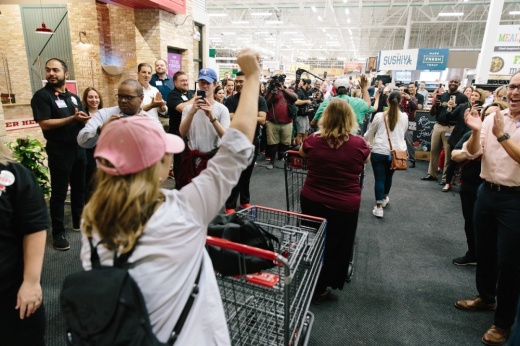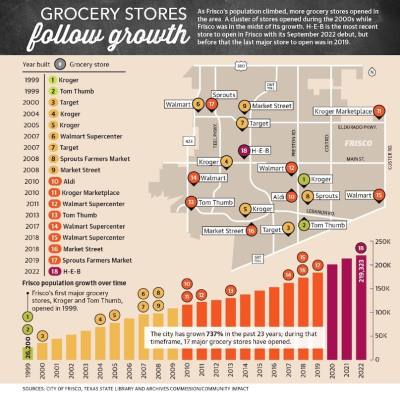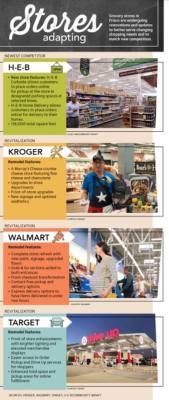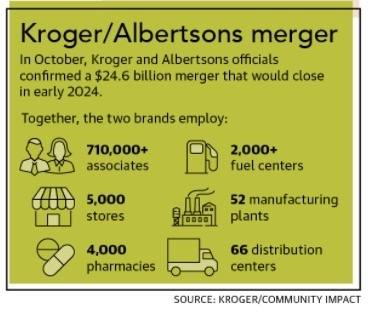H-E-B’s expansion into Frisco and surrounding cities along with an October announcement of a merger between two other major players, Kroger and Albertsons, are just the most recent of changes. Other stores across the city have also undertaken major remodeling projects and upped efforts to recruit workers.
“Competition is good in a free and open and growing market,” said Tony Felker, president and CEO of the Frisco Chamber of Commerce. “Competition is good in terms of bringing prices down, increasing selections, increasing innovation, making certain that competition drives good innovation and even renovation in stores.”
H-E-B’s first Dallas-area location opened in Frisco on Sept. 21 to lines of eager customers. The 118,000-square-foot store includes a full-service pharmacy with a drive-thru, an outdoor essentials department and a True Texas BBQ restaurant.
Meanwhile, Kroger and Albertsons officials on Oct. 14 confirmed a merger in which Kroger will acquire all of the shares of stock and properties of Albertsons for $24.6 billion by 2024, according to a news release. This includes Dallas-area affiliate stores Tom Thumb and Market Street. Kroger in the past year has also renovated local stores, opened an automated fulfillment center in Dallas and implemented hiring initiatives.
Over the past year, Walmart, too, has completed store renovations and expanded its subscription service. Local Target and Tom Thumb stores have also undergone renovations.
Capitalizing on growth
As H-E-B staff considered where to expand, they looked at the growth occurring in Collin and Denton counties, said Mabrie Jackson, senior director of Public Affairs for H-E-B.
“As we think about the future of our business and position ourselves for success, we look at several deciding factors, such as market demand, strong population growth and real estate,” she said in an email.
Between the 2010 census and the 2020 census Frisco’s population increased more than 71%. The city has also become increasingly more diverse, with the city’s Asian demographic growing the most between the decennial census at 355% to 26.27% of the Frisco population. Grocers catering to this demographic have also established locations in Frisco, including Patel Brothers, 99 Ranch, India Bazaar and more.
H-E-B saw a chance to move into a strong business environment, Felker said. With developments, such as the new headquarters of the Professional Golfers’ Association of America and the mixed-use development Fields that will bring in more than 3,500 homes, opening an H-E-B in Frisco presented a “win-win” situation for the city and the grocer, he said.
“I think H-E-B looked at that and said, ‘Let’s capitalize,’” Felker said.
With people likely driving from neighboring communities to visit the newest grocery offering, H-E-B is also serving to bring in outside tax dollars to Frisco—a phenomenon Felker said will likely continue.
“I bet anything that you got people coming down here from Oklahoma,” Felker said. “So it is an economic development tool.”Renovating for shopping trends
In the past year, Kroger and Walmart have held grand reopenings for three grocery stores in Frisco after renovations, which included increasing general aesthetics and catering to the shopping demands of the post-pandemic customer. Tom Thumb and Target are among the brands joining Walmart and Kroger in changing the look of stores.
U.S. Census Bureau data from August 2020 shows, during the pandemic, online shopping rapidly increased. Data shows this shopping sector experienced an estimated 10 years of growth within three months.
“Because people didn’t have a lot of options for shopping, online methods were a more approachable way to continue shopping,” said Kiseol Yang, a professor and digital retailing degree program coordinator at the University of North Texas.
John Votava, director of corporate affairs for Kroger, said the retailer sets out with a targeted list of stores in need of a refresh each year.
Walmart’s updates to three of its four Frisco stores include offering pickup, delivery and express deliveries in under two hours when construction is completed. The changes will also make Walmart+, the chain’s membership service, available to more customers, according to a news release from the retailer.
The retail giant experienced more people shopping online during the pandemic, which persists today, said Rissa Pittman, a Walmart market manager. The demand for Walmart’s pickup and delivery services has led the company to increase its order fulfillment capacity by 40% over the last two years, according to Walmart Communications Director Lauren Willis.
“We’ve expanded a lot of things in that [online grocery] space as far as time slots and more availability in each time slot to handle more customers each hour,” Pittman said. “That’s been a huge shift in the shopping trend.”
Technology advancements
In July, Kroger’s membership program, Boost by Kroger, was unveiled, and Kroger also opened a new automated fulfillment center in Dallas. It uses robot technology and other solutions to bring groceries to customers’ doorsteps. With a fleet of Kroger delivery vans, Kroger is now able to reach broader markets, Votava said.
“We don’t have any stores in Austin or San Antonio or Oklahoma City,” he said. “But now with this fulfillment center, we can reach customers in those areas and bring groceries directly to them and allow them to save in the process too. So it definitely expands our footprint without brick-and-mortar stores.”
Grocery stores have also pushed their mobile apps since the pandemic hit, which helps keep customers engaged as information is provided right at the shopper’s fingertips, Yang said. Apps and services, such as Walmart+, are ways to increase customer loyalty to the retailer, she said, and have effectively replaced the plastic store card that would hang on customer keychains.
“People use curbside pickup or Instacart, because they practiced this during the pandemic, and they found these reliable services,” Yang said.
Another way stores are staying competitive is appealing to hybrid shoppers, Willis said. Many people who shop in stores are also using their devices to read reviews online or find which aisles products are on.
“Before, you might have had strollers in boxes,” she said. “Now, we’ll have the different kinds of strollers we sell put together. ... And then there’s a QR code on there, and you just scan it, and it gets delivered to your home.”
For Walmart, the majority of customers are still shopping in physical stores, but there has been a large growth in the retailer’s online business, Pittman said.
Despite the technological advancements, in-store shopping is here to stay, Yang said.
“People still like to go and shop. So stores need to be there for the customers who like that kind of store experience,” Yang said.
Luring workers
The Frisco H-E-B location is the first of five in the Dallas-Fort Worth area that are planned to open in the coming year. A Plano store is scheduled to open Nov. 2, and a location in McKinney is scheduled to open in summer 2023. Each store will employ more than 700 positions with pay starting at $15 an hour, Jackson said.
Meanwhile, Kroger and Walmart officials announced new hiring initiatives in September. Kroger’s starting pay is $11.50 an hour and Walmart’s is $13 an hour. Both companies said they hope to compete for employees in ways besides pay.Votava said the company’s benefits and retirement pension make it an attractive option for potential employees. Kroger’s college tuition reimbursement plans are another benefit, he said.
Degree programs and 401(k) matches are also incentives Walmart offers to employees, Willis said.
“In the Frisco area, you have stores here that really wanted to be competitive against H-E-B when they opened, and one thing that we really have focused on is the associate experience,” Pittman said.










